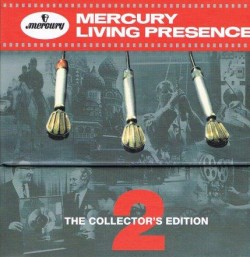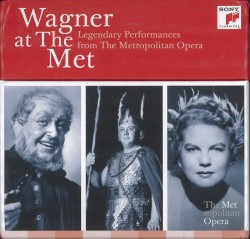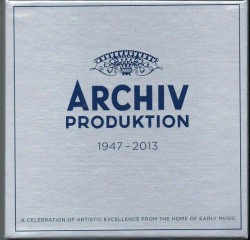Mercury Living Presence guarantees on the label that the recording, from performance to finished product, has maintained a sonic integrity that could very well mirror the Hippocratic Oath to “do no harm.”
The first of their recordings came to us in Australia on the HMV label and I can still recall the excitement generated by the astounding realism of the 12” LP of the 1951 performance of Rafael Kubelik conducting the Chicago Symphony in Pictures at an Exhibition. That performance remains a first choice in every respect. It mattered not that the recording was superior to the commercially available pick-ups and electronics of the day. Mercury has come a long way since then but the truthfulness of all their recordings remains and we hear what was heard at the sessions, without an engineer spotlighting or rebalancing the dynamics as chosen by the performer or conductor.
 Mercury Living Presence: The Collector’s Edition, Volume 2 (028947 85092, 55 CDs) in a limited edition is now available, filling in some of the omissions in Volume One. (Issued 15 months ago Volume One is now out of print and copies offered on-line range from $500 to a ridiculous $1900). In addition to some usual repertoire items, including Beethoven’s Fifth, Sixth and Seventh (Dorati), complete ballets: The Nutcracker, Coppelia, Sylvia and Le Sacre du Printemps (Dorati, 1953); there are many composers and compositions that could only appear in a collection so diversified as this one. There are eight discs of Paul Paray’s superb performances of French music with the Detroit Symphony including a ripping version of the Saint-Saëns Third Symphony with Marcel Dupré, Florent Schmitt’s La Tragédie de Salomé, his own Mass for the 500th Anniversary of the Death of Joan of Arc, plus all the overtures and bonbons you could wish for by Ibert, Ravel, Gounod, Saint-Saëns, Bizet, Berlioz, Massenet, Thomas, Herold, Auber, Debussy and lots of Chabrier. Also works by Liszt and Richard Strauss. Marcel Dupré has a disc of Widor and Franck. Harpsichordist Rafael Puyana has three CDs containing works by Picchi, Frescobaldi, Telemann, Scarlatti and the Bachs, JS, JC and WF. The third disc, The Golden Age of Harpsichord Music from anonymous to Couperin le Grand is quite enchanting. Howard Hanson with the Eastman Rochester has no less than ten discs, eight of which are devoted to American composers including, to my great pleasure, Chadwick’s 30-minute Symphonic Sketches that comprise four pieces including Jubilee. Also two volumes aptly titled Music for Quiet Listening.
Mercury Living Presence: The Collector’s Edition, Volume 2 (028947 85092, 55 CDs) in a limited edition is now available, filling in some of the omissions in Volume One. (Issued 15 months ago Volume One is now out of print and copies offered on-line range from $500 to a ridiculous $1900). In addition to some usual repertoire items, including Beethoven’s Fifth, Sixth and Seventh (Dorati), complete ballets: The Nutcracker, Coppelia, Sylvia and Le Sacre du Printemps (Dorati, 1953); there are many composers and compositions that could only appear in a collection so diversified as this one. There are eight discs of Paul Paray’s superb performances of French music with the Detroit Symphony including a ripping version of the Saint-Saëns Third Symphony with Marcel Dupré, Florent Schmitt’s La Tragédie de Salomé, his own Mass for the 500th Anniversary of the Death of Joan of Arc, plus all the overtures and bonbons you could wish for by Ibert, Ravel, Gounod, Saint-Saëns, Bizet, Berlioz, Massenet, Thomas, Herold, Auber, Debussy and lots of Chabrier. Also works by Liszt and Richard Strauss. Marcel Dupré has a disc of Widor and Franck. Harpsichordist Rafael Puyana has three CDs containing works by Picchi, Frescobaldi, Telemann, Scarlatti and the Bachs, JS, JC and WF. The third disc, The Golden Age of Harpsichord Music from anonymous to Couperin le Grand is quite enchanting. Howard Hanson with the Eastman Rochester has no less than ten discs, eight of which are devoted to American composers including, to my great pleasure, Chadwick’s 30-minute Symphonic Sketches that comprise four pieces including Jubilee. Also two volumes aptly titled Music for Quiet Listening.
And that’s not even half of what’s in the box. For detailed contents go to deccaclassics.com/us/cat/single?PRODUCT_NR=4785092.
 Today millions of people around the world, sitting comfortably in their local cinema, are seeing live performances direct from the Metropolitan Opera in New York City. Previous generations only heard live Met performances at home, sitting around their radios and for the most part not visualizing the settings but simply listening to the music and enjoying the artistry of a favoured singer and conductor.
Today millions of people around the world, sitting comfortably in their local cinema, are seeing live performances direct from the Metropolitan Opera in New York City. Previous generations only heard live Met performances at home, sitting around their radios and for the most part not visualizing the settings but simply listening to the music and enjoying the artistry of a favoured singer and conductor.
Recently, Sony Music has issued a few single CDs of complete operas from the radio era derived from the Met’s own archives. Now they have a 25-CD boxed set of nine renowned performances of Wagner’s music dramas from 1936 to 1954.
The earliest of these is Götterdämmerung from January 11, 1936 boasting the incomparable Wagnerian heldentenor of the day, or maybe any day, Lauritz Melchior as Siegfried and Marjorie Lawrence singing Brunnhilde. Friedrich Schorr was Gunther and Ludwig Hoffmann sang Hagen. Artur Bodanzky conducted. Lawrence made history when she surprised and thrilled the audience and horrified the Metropolitan management by mounting and riding a live horse into the flaming Valhalla. I had hoped that the sound on the Götterdämmerung transfers would be cleaner than the Naxos edition but it is not. Clearly they are each based on the same source. The valorous decision to include this performance was an artistic choice, not a technical one. The sound of Götterdämmerung is atypical of the rest of the Ring and the other five dramas which are all eminently listenable and enjoyable. As a matter of interest, the selection of the repertoire was discussed between the Metropolitan Opera and Sony Masterworks who came to a joint agreement on the performances.
Very briefly, the others are Das Rheingold (1951) with Set Svanholm singing Loge, Hans Hotter is Wotan, Jerome Hines is Fasolt, and Jarmila Novotná is Freia. Fritz Stiedry conducts. Siegfried (1937) has Melchior at the anvil with Kirsten Flagstad’s Brunnhilde and Friedrich Schorr as Wanderer. Die Walküre (1940), complete with a wind machine in the opening, has Melchior and Lawrence as Siegmund and Sieglinde with Flagstad as Brunnhilde. Leinsdorf conducts.
Another Flagstad/Melchior collaboration is Tristan und Isolde (1938) and while the original discs are not quite pristine, the voices are clear. Bodanzky conducts. Lohengrin (1943) stars Melchior with Astrid Varnay as Elsa conducted by Leinsdorf. Fritz Reiner conducts Der Fliegende Holländer (1950) with Hotter, Varnay and Svanholm. Die Meistersinger von Nürnberg (1953) is conducted by Reiner with Hans Hopf as Walter, Victoria de los Angeles is Eva and Paul Schöffler is Hans Sachs. Finally, Tannhäuser (1954) has George Szell in the pit with Varnay as Venus, Raymón Vinay as Tannhäuser and George London as Wolfram.
This impressive collection of legendary performances, Wagner at the Met (88765 427172, 25 CDs) includes a 128-page booklet with historic photographs, etc. but, of course, no libretti. The Met is quite serious about bringing their archives to life: Grace Row, the producer who oversaw the restoration and mastering of these performances, was previously a producer at Sony Classical in the 1990s and is now the in-house producer at the Met.
A similar collection of Verdi at the Met will be issued this fall… a welcome prospect of hearing further legendary voices in their prime.
 In 1941 Deutsche Grammophon was purchased by Siemens Electronics and following WW2 in 1947 it was proclaimed that DGG, Deutsche Grammophon Gesellschaft, had formed Archiv, a special division to document Germany’s rich musical culture. Performances were to be historically correct in every detail with musicians playing on authentic period instruments following the performing practice of the time. Their first recording was of Helmut Walcha playing works by Bach on a small baroque organ built in 1636 housed in the Lübeck Jacobikirche. Those first sessions are to be found on the first disc of an important, strictly limited edition, Archiv Produktion 1947-2013 (00289 4791045, 55 CDs) that contains delicious performances of treasures from Gregorian Chant to Beethoven. Sometime after 1947 it was reported to “Mister Siemens” that the Archiv division was losing money. His emphatic response, I am told, was that this was of no concern as they were not in it to make money! Meticulously assembled, the early LPs were in fold-out jackets with a certificate enclosed, signed by the persons involved in the production of the disc! The 55 CDs are housed in a silver presentation box that contains a 200-page booklet detailing all the particulars of each disc plus a history of the label and lots of colour photographs of the artists. I’m sure many will find this package, subtitled “A Celebration of Artistic Excellence from the Home of Early Music,” irresistible… and rightly so. For full details check deutschegrammophon.com/en/cat/single?PRODUCT_NR=4791045.
In 1941 Deutsche Grammophon was purchased by Siemens Electronics and following WW2 in 1947 it was proclaimed that DGG, Deutsche Grammophon Gesellschaft, had formed Archiv, a special division to document Germany’s rich musical culture. Performances were to be historically correct in every detail with musicians playing on authentic period instruments following the performing practice of the time. Their first recording was of Helmut Walcha playing works by Bach on a small baroque organ built in 1636 housed in the Lübeck Jacobikirche. Those first sessions are to be found on the first disc of an important, strictly limited edition, Archiv Produktion 1947-2013 (00289 4791045, 55 CDs) that contains delicious performances of treasures from Gregorian Chant to Beethoven. Sometime after 1947 it was reported to “Mister Siemens” that the Archiv division was losing money. His emphatic response, I am told, was that this was of no concern as they were not in it to make money! Meticulously assembled, the early LPs were in fold-out jackets with a certificate enclosed, signed by the persons involved in the production of the disc! The 55 CDs are housed in a silver presentation box that contains a 200-page booklet detailing all the particulars of each disc plus a history of the label and lots of colour photographs of the artists. I’m sure many will find this package, subtitled “A Celebration of Artistic Excellence from the Home of Early Music,” irresistible… and rightly so. For full details check deutschegrammophon.com/en/cat/single?PRODUCT_NR=4791045.



